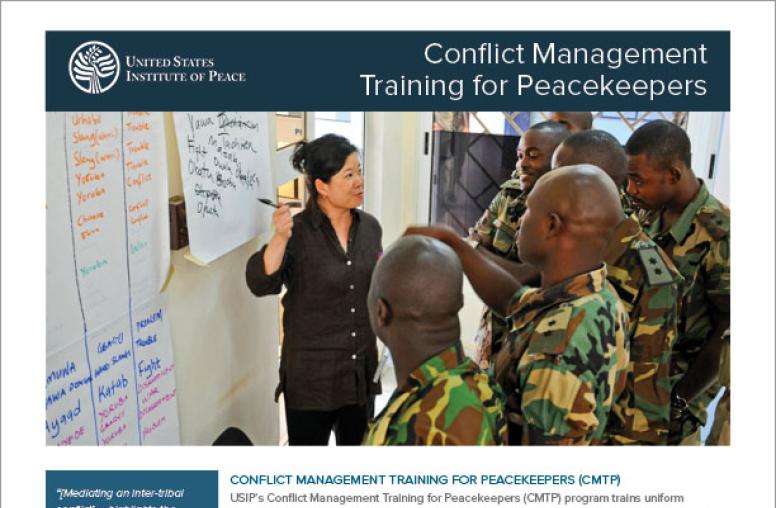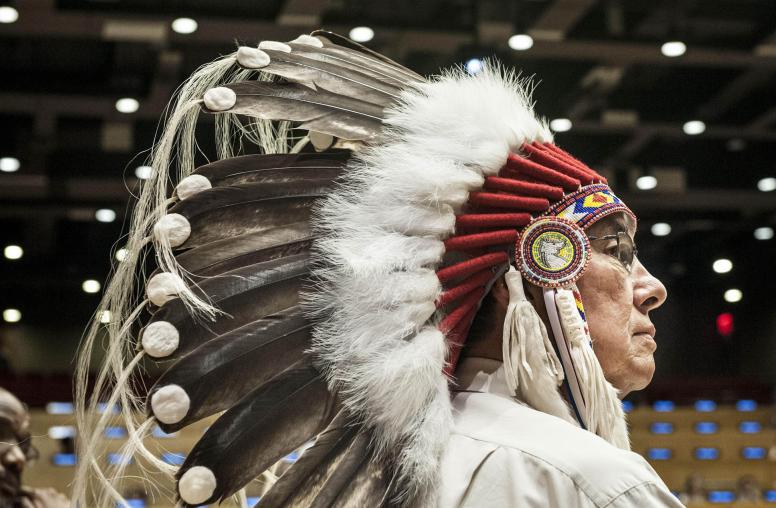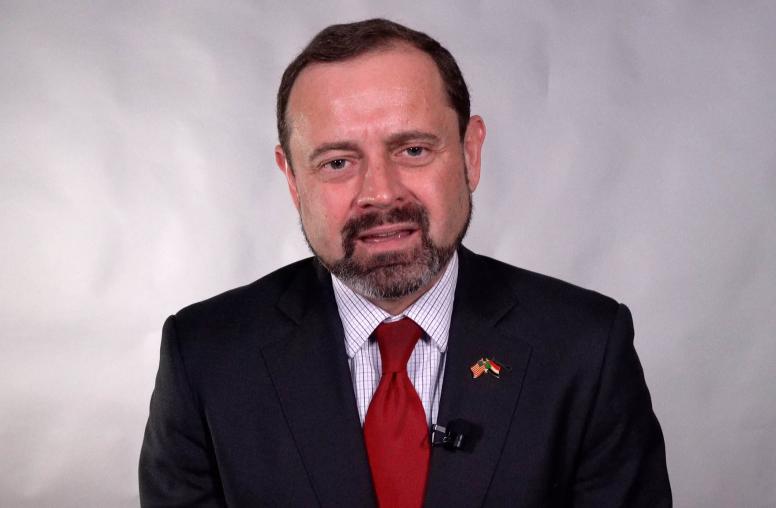The Role of Accessibility and Funding in Disability-Inclusive Peacebuilding
Persons with disabilities are finding seats at the peacebuilding table — but full participation requires accommodations.
Persons with disabilities are often left out of peace processes despite comprising an estimated 15 percent of the world’s population. Among those most acutely affected by violence and armed conflict, persons with disabilities who are living in — or attempting to leave — conflict zones face numerous threats to their physical and mental wellbeing, which can aggravate pre-existing disability or lead to secondary disability. Armed conflict and violence also increase the number of newly acquired disabilities, and many of those individuals face the same barriers and challenges as persons with existing disabilities — but without the previous lived experience.

Meanwhile, gaps in post-conflict reintegration processes, especially in addressing the needs of ex-combatants and civilians with newly acquired disabilities, as well as pervasive societal stigma and discrimination against persons with disabilities, only serve to amplify experiences of marginalization and add to grievances.
In recent years, organizations of persons with disabilities (OPDs) have been tirelessly working to change this. These groups have played a growing role in conflict and post-conflict settings by leading peacebuilding programs, advocating for greater disability representation in official processes, participating in these processes and ensuring that disability rights are included in official documents.
OPDs are led — and primarily staffed and governed — by persons with disabilities that can draw on their lived experience and their connections with their own communities to develop programs and lead advocacy around disability rights. But at the same time, OPDs are hampered by a lack of funding and accessibility failures that make it harder for them to do their work.
A Lack of Direct Funding
In a recent USIP-USAID joint roundtable on how U.S. foreign assistance can help persons with disabilities prevent and respond to violence in their communities, several participants noted that currently, U.S. government funding is generally directed toward larger, national civil society organizations or international NGOs instead of local OPDs. In these scenarios, OPDs are sometimes brought on as a sub-contractor or a partner later in the project, but this doesn’t offer access to the same resources that they would have if they were a primary partner.
When not funded directly, OPDs are often not provided opportunities to develop greater financial, administrative and project management capacity. And more importantly, when disability programming is developed without the involvement of OPDs as primary partners, this programming fails to benefit from the expertise and connections of OPDs.
Atim Caroline Ogwang, founder of the South Sudan Women with Disabilities Network, also noted the risk that OPDs often become tokenized — pointing out that many recipients of U.S. funding will nominally commit to include persons with disabilities in their programming, referencing OPDs vaguely, but ultimately fail to include them down the line. And this risk is only heightened when peacebuilding organizations do not have persons with disabilities among their core staff.
To fix these issues, participants in the roundtable — which included 28 people from 11 conflict-affected countries alongside representatives from the U.S. government and the broader peacebuilding community — offered several concrete suggestions for facilitating direct U.S. funding to OPDs. To start, the U.S. government can conduct training for these organizations on organizational development, create direct funding opportunities that are only open to OPDs and ensure that OPDs are informed of these opportunities. Additionally, foreign donors should implement systems that hold funding recipients accountable for including persons with disabilities throughout the lifecycle of a program, not merely as beneficiaries, but from design through learning.
For an Inclusive Peace Process, Accessibility is Key
Another recommendation from participants: requiring that program design, planning and budget lines factor in reasonable accommodations at the inception to ensure large grants or agreements are providing for the inclusion and active participation of persons with disabilities. Best practices show that 5-7% of a program’s budget should go toward reasonable accommodations in targeted programming for persons with disabilities, with 1-3% being an appropriate guide for mainstream programming inclusive of persons with disabilities.
Accessibility is a foundation of inclusive peacebuilding — and a critical step in enabling the participation of persons with disabilities. U.S.-supported peacebuilding programs can provide the assistive technology and devices necessary for full participation, and these must be integrated at the earliest possible stage.
When accessibility is only considered at the last minute, the accommodations are more likely to be insufficient. It’s not only about inviting people with disabilities to participate, said Syrian activist Batool Abuali, but rather it is “a whole process of listening, understanding and making the adjustments.” Why offer a seat at the table when a person with a disability may not even be able to get in the room?
Participants also discussed how people with disabilities can experience exclusion based on their intersecting identities. For example, women and girls with disabilities face specific, unique barriers in post-conflict settings — including higher rates of gender-based violence and increased exclusion from economic, health and livelihoods programming. In many contexts, women and girls with disabilities have less access to justice and to critical services, like health and education.
Similarly, youth with disabilities and older persons have found that they face their own unique challenges that are often left out of peacebuilding conversations. Ultimately, we need stronger integration of disability rights into key international movements such as the global Women, Peace and Security agenda and Youth, Peace and Security agenda — including data on how much these two movements have integrated disability rights to date.
Beyond the integration of dynamics for women and youth with disabilities, roundtable participants also highlighted several other key intersections. Even among persons with disabilities, there is great diversity. As Bethany Brown from the International Disability Alliance stated: “We see there are more marginalized disabilities, and all of us need to be brought to the table equally. This includes persons with intellectual disabilities, persons with deafblindness, and others from the broader disability community.”
Additionally, there is no information on — and little formal representation of — persons with disabilities who are members of nomadic or pastoralist communities, though these communities are often discussed in relation to peacebuilding efforts. And whereas persons with disabilities may struggle to seek refuge from conflict, climate change-related disasters now pose parallel threats — often in the same contexts.
Persons With Disabilities: A Source of Peacebuilding Solutions
Persons with disabilities can be — and have been — the source of solutions in peacebuilding initiatives. Participants in the roundtable emphasized that persons with disabilities are some of the strongest advocates in building peace, especially after experiencing violence themselves.
Nay Lin Soe from Myanmar emphasized that persons with disabilities can often be knowledgeable about how best to address violence — meaning OPDs should involve themselves as much as possible to make sure all programs are inclusive of everyone. For example, other participants noted that many survivors of landmines, particularly those in Colombia, have become activists even after the violence of armed conflict ends.
Persons with disabilities can also play a major role in building bridges across conflict contexts. Support and activism around disability rights can serve as a unifying issue even when parties are otherwise at odds. Participants emphasized that these connections need to be explored more — as well as funded. From Northern Ireland, to Georgia, to the Balkans, disability activists have already been doing the work to bridge these divides and work toward peace.
To that end, as part of the 2022 Global Disability Summit, USAID committed to implement key disability-inclusive peacebuilding practices. This includes: supporting persons with disabilities and their organizations as they respond to conflict and violence in their communities; further understanding the barriers to women with disabilities’ meaningful participation in peacebuilding; and building internal staff capacity around disability inclusion. Alongside this effort, USIP has recently initiated a program to increase the participation of persons with disabilities throughout USIP’s programming, generate knowledge and best practices on how to support and build the capacity of OPDs in peace processes and encourage greater disability inclusion in the broader peacebuilding field.
For both USAID’s and USIP’s efforts, as well as those of the broader peacebuilding field, there are key takeaways that are vital to ensuring persons with disabilities are included in mitigating conflict, preventing violence and ensuring inclusive peace processes:
- Emphasize accessibility upfront in any program or process through adequate financial support to OPDs and the provision of reasonable accommodations for physical, information, and communication accessibility.
- Recognize that solutions for accessibility from the Global North may not always be financially viable or culturally appropriate in lower- and middle-income contexts. Listen to local OPDs and integrate their knowledge of both the context and the disability community into any peacebuilding initiative.
- Bridge the divide between the different peace and security movements that address the challenges of women, youth and persons with disabilities in conflict. This includes collecting data across the different intersections.
- Lastly, recognize the positive role that persons with disabilities can have in affecting change in conflict-affected contexts and post-conflict reconstruction. Protection needs are often vital — but shifting the paradigm to recognize the strategic advantage of OPDs to advocate for peace and security will ensure that no one gets left behind.
Rashad Nimr is the inclusive peacebuilding advisor for the U.S. Agency for International Development's Center for Conflict and Violence Prevention.



